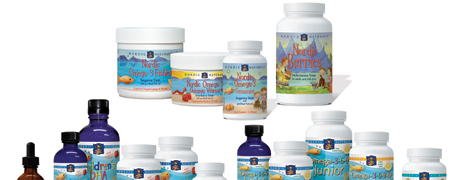Features
Children of Convenience
Today’s parents are so busy that the market is growing for dietary supplements, fortified foods and nutritional beverages for kids.
By: Amanda Baltazar

Busy, busy, busy. It’s almost a mantra these days and it’s ubiquitous.
As a result, the diets of Americans have changed. Commonplace foods are processed, with the nutrients taken out of them.
But recent health crises among children and a demand for better, more sensible products from parents have pushed many companies to add health—and more—back into foods and beverages today.
And there’s no one for whom that’s more important than children. Growing bodies and minds need fuel and it needs to be nutrient-packed.
Currently, the hot ingredients are omega 3 fatty acids (i.e., DHA), pre- and probiotics, vitamin D and calcium, and manufacturers are putting these into all types of foods, beverages and supplements to try to enhance the diets of kids of all ages.
Boosting the Health of a Calorie-Rich, Nutrient-Poor Generation
What is this doing for our children? On the one hand, it’s boosting the health of a generation that eats poorly. A recent report from the U.S. government, published in the October 2010 issue of the Journal of the American Dietetic Association, showed that American kids are filling up on empty calories.
Equally worrying, the report showed that almost 40% of children’s calories come from solid fat and added sugars and half came from just six foods/beverages: soda, fruit drinks, dairy desserts, grain desserts, pizza and whole milk.
On the other hand, nutritionists are concerned that fortified foods are leading parents to believe their offspring are obtaining all the nutrition they need.
“Parents are going for this lesser-than-evil,” said Melissa Abbott, trends and culinary insights director, The Hartman Group, Seattle, WA. “They give their child Pirate’s Booty instead of a proper meal, or if they won’t eat a proper meal. They feel that at least the child is getting some nutrition and these foods are largely to make the parents feel better. It lessens the guilt of the parents.”
But there’s no proof these foods are actually safe. According to Christen Cooper, MS, RD and founder of Cooper Nutrition in Pleasantville, NY: “The average child can survive quite well eating normal food. That is, of course, if the child is eating a healthy, well-rounded diet.
“Scientists do not know enough about what happens when we remove one component of a food, such as omega 3 fatty acids, or certain vitamins and minerals, then isolate them and add them to other foods. Furthermore, companies can charge extra for what may actually prove to have little value for the consumer.”
On the other side of this debate sits Elizabeth Somer, RD, author of Eat Your Way to Happiness, who is a big advocate for supplementation. “There are few people in the U.S. who are eating perfectly. An FDA study found only one in 100 people was eating perfectly. Especially little children don’t eat well—they go on food jags.”
Ingredient Headliners
Parents tend to fall into the same camp as Ms. Somer, prompting a huge demand for fortified foods and beverages specially formulated for children.
According to New York, NY-based Datamonitor, the percentage of new fortified kids’ beverages featuring DHA rose to more than 16% in 2010 (up from just less than 3% in 2009) and expanded to more than 33% in supplements (up from 25% in 2009).
The percentage of new fortified children’s foods containing vitamin D rose to more than 12% in 2010 (up from just less than 3% in 2009), while the percentage of new supplements containing vitamin D hit 24% in 2010.
By and large, the products making these claims, explained Tom Vierhile, director of Datamonitor’s Product Launch Analytics, were yogurt, cereal bars, pasta and poultry/poultry products.
Martek Biosciences, Columbia, MD, is the manufacturer of life’sDHA, a vegetarian, sustainable source of the omega 3 fatty acid DHA.
Martek’s DHA can be found in more than 99% of infant formulas on the U.S. market. It’s also used in foods and beverages targeted directly at children, such as Horizon Organic Milk and Pediasure. This spring it will also be in a new line of toddler vitamins called Brain Strong. These will be in the form of a sachet of flavorless powder for the very young (ages one through three) and gummies containing 100 mg of DHA per serving for kids aged three plus.
Martek’s DHA is different from others, according to company spokeswoman Cassie France-Kelly, because it’s made from algae. Its DHA ends up in children’s products, she said, because kids are a really vulnerable population. “It’s in breast milk and formula but when they are weaned, unfortunately in the western diet, DHA intake falls off because it’s found mainly in fatty fish. DHA is very important to brain development and brain health.”
A new product enjoying recent success is Mojo Milk. Launched in November 2010, it delivers 10 times the probiotics of yogurt and comes in powder form, in individual stick packs.
Peter Leighton, a partner in Natural Discoveries, owner of Mojo Milk, was one of the people behind the product’s creation. “Seeing the chocolate milk on the market, none of them were healthy, so I started doing some research,” he said.
In the course of this he discovered the probiotic GanedenBC30, which, said Mr. Leighton, is the only probiotic that has been clinically shown to survive the application of heat and the acidity of digestion. “This one expands or grows in the gut so the good flora proliferate,” he added.
Each of the stick packs delivers 2 billion CFU (colonizing units, which support enhanced immune function and digestive health benefits. Half of this would be sufficient, but the company put in more to ensure children get all they need.
“We wanted a better version than Nesquik,” said Mr. Leighton. “So we looked at nutritionally what children are lacking that would make the biggest impact on their health.”
Although, of course, Mojo Milk is providing kids with calcium, the company can’t make any claims about that since they don’t supply the milk.
One company that is proud of how it helps get calcium into little bodies is FrieslandCampina Domo. This Paramus, NJ-based company develops and produces Vivinal GOS—a prebiotic galacto-oligosaccharide that has been shown to improve calcium and mineral absorption, primarily through its action in the large intestine.
Unlike other prebiotics, it’s fermented in the colon to produce short chain fatty acids, which help to lower the pH of the colon, thus creating a more acidic environment, making it easier for bound calcium to become soluble and pass into the blood stream.
In addition, Vivinal GOS helps to increase secretion of the calcium transporter protein Calbindin, which also facilitates calcium uptake and absorption.
Vivinal GOS has only been in infant formulas since 2008, but in just three years has grown to capture almost the entire U.S. market.
“It was not so much a case of one manufacturer following another but an industry recognition of the importance of prebiotics for immunity,” said Sarah Staley, vice president of business development for the Americas.
Infant formula is an ideal application for Vivinal GOS, she explained. “Manufacturers realize that for consumers to get the benefits of prebiotics, they need to consume them every day.” But, she added, these manufacturers are starting to get more adventurous in where they put them, such as chocolates and snack bars.
“Manufacturers recognize that dairy products are not widely used by some demographic groups so other vehicles for delivery of this important component are becoming more prevalent. Offering different product options gives people more opportunities to consume prebiotics in efficacious amounts on a daily basis.”
And awareness of calcium’s importance is growing, too.
“For older children, particularly girls, it is important to get adequate calcium intake. Optimal calcium absorption occurs up to the end of the teenage years. Vivinal GOS can assist with calcium absorption for this age group, helping ensure adequate calcium is available for healthy bone development.”
On the other side of the product spectrum, Soothie Suckers makes popsicles that are infused with herbs to treat children’s colds, sore throats and boost immunity.
The Grape-flavored Cold Fighter, for example, contains mullein leaves, saw palmetto, eyebright, horehound and cayenne fruit. Together, these herbs help expel and reduce mucus and boost the body’s immune system, while anti-inflammatory agents reduce swelling and pain.
Soothie Suckers’ CEO Marietta Harrison devised the products alongside a master herbalist who has more than 40 years of experience. The products were launched last summer.
Soothie Suckers are aimed at children aged two through 12. “Kids seem to love the distraction of a delicious tasting pop,” explained Ms. Harrison, adding that the popsicles soothe, especially sore throats.
Parents love them, too: They’re hydrating so they know their child is getting liquids. And there’s no sugar, artificial colors, flavors or preservatives.
“Herbs are supportive to the body’s natural systems rather than invasive, as are most of our Western medicines,” said Ms. Harrison. “This is especially important for kids: To ingest products that stimulate their immune system rather than override it.”
Fairlight Bakery, Vancouver, WA, launched its products four years ago and now, the Zac O Mega Bars and Zac Attack Snack Bars are going gangbusters in schools, where they’re dished up for breakfast and snack times.
These refrigerated bars contain 1.3 grams (Zac O Mega Bars) and 500 mg (Zac Attack Bars) of ALA omega 3 fatty acids. There are no FDA requirements for omega 3s, explained president Tom Fitzgerald, but recommendations from various sources suggest 1.3 grams and 1.6. “So even with 1.3 grams we’re giving kids 85% of an adult’s daily requirement.”
The Supplement Side
Along with foods and beverages, supplements designed specifically for children are also enjoying a measure of success.
Nordic Naturals, Watsonville, CA, has several products for kids, including Children’s DHA, Baby’s DHA, Omega-3.6.9 Junior and Omega-3 Effervescent.
“Pre-birth through age two and three represents the most critical time for children because it’s when the brain is developing,” said Corinna Bellizzi, division manager. “If they’re not getting enough omega 3 and DHA in those years it could negatively impact brain development.”
Children need supplements of these foods now, she added, because they eat a lot more saturated fats and different oils than 30 or 40 years ago, “so they’re not getting the fatty acids they need.”
Nordic Naturals does have omega 3 gummi products for children and while Ms. Bellizzi said she realizes that this isn’t the healthiest choice for a child, she concedes that it’s “a necessary product that helps us reach the almost unreachable consumer. With our young and most discerning crowd, taste is always king.”
Even better, there’s a liquid omega 3 supplement, which actually contains more omega 3 than the gummies, and is one of the most popular supplements in the company’s line.
Sales of these products are growing, as parents become more aware of the need for omega 3s and they move into the mainstream.
“It’s a supplement that everyone has a need for because our diets have changed a lot in the past 50 years,” pointed out Ms. Bellizzi. “It’s never too late to start your children on omega 3s.”
At the end of the day, there’s a place for all of these products in a child’s diet, and that diet is preferably one that also contains healthy proteins, vegetables and dairy. Americans aren’t going to become less busy—unless they’re very lucky—so expect to see more supplements, fortified foods and beverages that are designed to keep our soon-to-be busy kids as healthy as they can be.
What About Tweens & Teens?
While many of the fortified foods on the market are designed for young children, with fun graphics and cute names, there’s another market segment that’s almost untapped: Tweens and teens.
A key nutrient for tween girls in this age group is calcium for bone density, according to Jared Reynolds, chief innovation officer, Nutraceuticals Research Innovations, Miami, FL.
“A pre-pubescent woman is not menstruating so her bone density is similar to a boy’s. But as she enters adulthood, that changes and there’s a need for iron, calcium and vitamin D, especially before she starts to menstruate.”
Mr. Reynolds said in the future he expects to see powdered add-ins for beverages that are loaded with bone density-focused nutraceuticals, such as vitamin D and calcium.
“I think it is hard to get tweens to take vitamins. It’s harder even than kids, who you can give chewy ones to. But drinks are more convenient, especially for the more active tweens and teens. Plus, if their mom tells them to do something, they probably won’t do it. So it needs to be in something they already like. I think you’ll start to see these things on the market in the next year.”
And for tween boys, we’ll see bulking up in a different form—for them it’s muscle rather than bone. This used to be the domain of teen males but younger boys are starting to take an interest in weight lifting, too, Mr. Reynolds explained.
“The key products for these tween and teen boys will be nutraceuticals that promote athletic performance, size and strength. This includes supplements and compounds found useful in muscle growth such as whey protein. An increasing area of nutraceutical research among this class of consumers is brain and mental health, a trend we see continuing.”
For boys, Mr. Reynolds said he expects to see powdered mix-ins, as well as power/protein bars and beverages. “They probably won’t promote them for the tweens but you may see some tween-friendly advertising/packaging.”
Offering one final prediction, Mr. Reynolds said, “The question will be how do we deliver the nutrients we know these kids need? Food is difficult because if you cook or alter the food you are probably hurting the chemical bond in the compound. Drinks are where I see the future.”




















